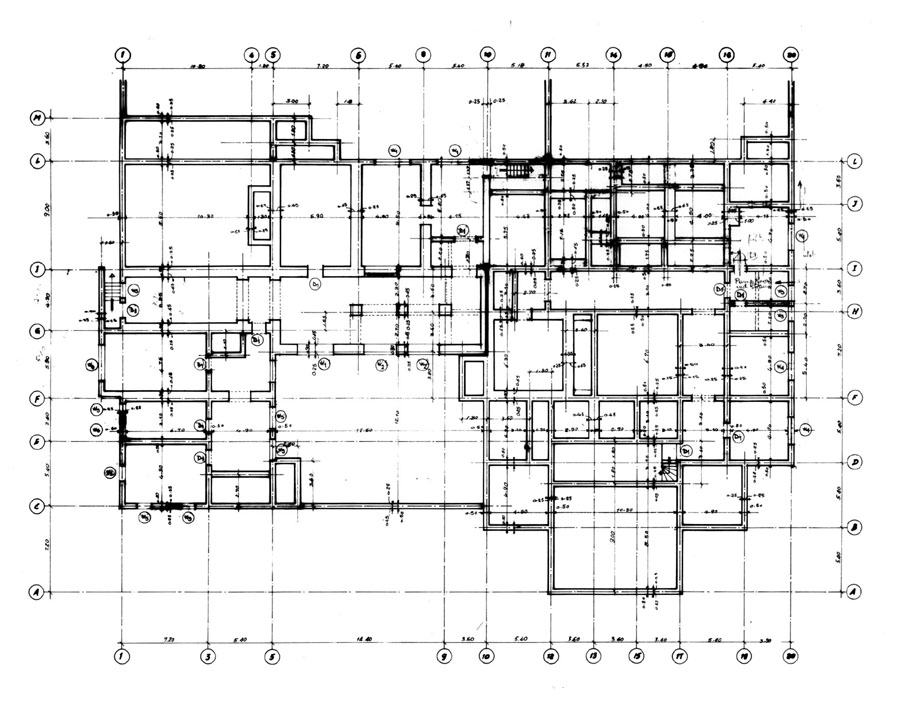Floor plan
[edit] 
Orthographic projection is a technique for drawing a three dimensional object in two dimensions, by ‘projecting’ its surfaces into a two dimensional representation, where the projection lines are orthogonal to (perpendicular to) the projection plane (that is, there is no foreshortening or perspective).
Floor plans are a form of orthographic projection that can be used to show the layout of rooms within buildings, as seen from above. They may be prepared as part of the design process, or to provide instructions for construction, often associated with other drawings, schedules, and specifications.
Floor plans may include key dimensions and levels, and may also use, hatching, symbols and other standard annotations and abbreviations to indicate materials, fittings and appliances, and so on.
Depending on the size of the building, floor plans are typically drawn at scales of between 1:200 and 1:20. Different line types, colours and weights can be used to differentiate between the types of drawn information they include.
Floor plans can be drawn for whole buildings, a single floor of a building, or just a single room. The more detailed the floor plan is in terms of layout, fittings and so on, the more useful and instructive it will be for the project. However, if spaces are complex, it is normal for separate drawings to be prepared for different trades, such as electrical and lighting drawings, plumbing drawings, and so on.
The lower-right-hand corner of the sheet is typically reserved for a title block. This provides a space to record the name of the project, the name of the drawing, the scale, the originators name, the date, revision history, and so on.
The floor plan view should be roughly centred on the sheet, with the front of the building typically drawn along the lower side of the sheet. A north point may be included to show the orientation of the floor plan.
Typically, the outside walls are drawn first, to lay the plan out on the sheet, then the internal walls, then windows, doors, stairs, lifts, ramps, and so on, are added. An arrow is used to indicate the upward direction of stairs and ramps. It is usual for a faint dotted line to be drawn around stairs (or other openings) where they are open at ceiling level.
Rooms should be clearly labelled, with block lettering in the centre of each room. The correct symbols should be added for elements such as; appliances, fixed furniture, fittings, building services, and so on.
Electrical symbols should be added to the drawing, indicating; power sockets, light switches, wall and ceiling lights, detectors and alarms, extract fans, and so on.
Items that are ceiling mounted, are generally drawn on the floor below their place of installation.
Dimension may be added to indicate the size and location of key elements such as; rooms, fittings, appliances or fixtures, external walls, window and door openings, and so on.
Section lines may be added where there are section drawings associated with the floor plan. Grid references may also be added to help co-ordinate the floor plan with other drawings.
Some floor plans may include notional furniture to help gauge the likely size of circulation spaces.
If a window or door schedule is to be prepared, doors and windows may be labelled with a number or letter, corresponding to an item on the schedule.
Floor plans should not duplicate information that is presented in specifications or schedules because of the potential for conflict. Instead they should refer to the specification or schedule.
[edit] Related articles on Designing Buildings Wiki
- Block plan.
- Common mistakes on building drawings.
- Decorating a newly built home.
- Drawing projections.
- Electrical drawing.
- Elevations.
- General arrangement drawing.
- Manual drafting techniques.
- Residential design and 3D rendering.
- Section drawing.
- Standard hatching styles for drawings.
- Symbols on architectural drawings.
- Techniques for drawing buildings.
- Types of drawings.
- Working drawing.
Featured articles and news
A change to adoptive architecture
Effects of global weather warming on architectural detailing, material choice and human interaction.
How big is the problem and what can we do to mitigate the effects?
Overheating guidance and tools for building designers
A number of cool guides to help with the heat.
The UK's Modern Industrial Strategy: A 10 year plan
Previous consultation criticism, current key elements and general support with some persisting reservations.
Building Safety Regulator reforms
New roles, new staff and a new fast track service pave the way for a single construction regulator.
Architectural Technologist CPDs and Communications
CIAT CPD… and how you can do it!
Cooling centres and cool spaces
Managing extreme heat in cities by directing the public to places for heat stress relief and water sources.
Winter gardens: A brief history and warm variations
Extending the season with glass in different forms and terms.
Restoring Great Yarmouth's Winter Gardens
Transforming one of the least sustainable constructions imaginable.
Construction Skills Mission Board launch sector drive
Newly formed government and industry collaboration set strategy for recruiting an additional 100,000 construction workers a year.
New Architects Code comes into effect in September 2025
ARB Architects Code of Conduct and Practice available with ongoing consultation regarding guidance.
Welsh Skills Body (Medr) launches ambitious plan
The new skills body brings together funding and regulation of tertiary education and research for the devolved nation.
Paul Gandy FCIOB announced as next CIOB President
Former Tilbury Douglas CEO takes helm.
UK Infrastructure: A 10 Year Strategy. In brief with reactions
With the National Infrastructure and Service Transformation Authority (NISTA).
Ebenezer Howard: inventor of the garden city. Book review.
Airtightness Topic Guide BSRIA TG 27/2025
Explaining the basics of airtightness, what it is, why it's important, when it's required and how it's carried out.





















